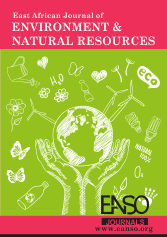Environmental Law and Conservation of Water Resources. A Case of River Rwizi in Sheema, Rwampara and Isingiro Districts in Uganda
Abstract
Water is an essential natural asset critical for human survival and societal development. It serves a wide range of purposes such as household use, transportation, industrial production and farming. Despite its importance, River Rwizi is facing severe environmental degradation, which is accelerating due to increasing population pressure. This study set out to investigate how environmental law affects the conservation of water resources along the River Rwizi, particularly in Sheema, Rwampara, and Isingiro Districts in Uganda. The core objective was to explore the challenges in enforcing water conservation laws in these areas. The research employed a cross-sectional design that integrated both qualitative and quantitative approaches. Quantitative data were summarised using frequency tables and percentages, while thematic analysis was employed for qualitative insights. The study focused geographically on the River Rwizi and its surrounding areas in the three districts. Key informants highlighted that enforcement efforts are constrained by limited manpower and equipment. Additionally, it was found that ensuring transparency and holding all offenders accountable, regardless of their social or economic status, is vital. The study concluded that conservation efforts are significantly weakened by inadequate enforcement resources and low public awareness. As a solution, it recommends that the government enhance investment in enforcement tools and that local collaboration among authorities, communities, and leaders be strengthened to support conservation efforts.
Downloads
References
Barman, A., Rajak, F., & Jha, R. (2024). Integrating wetlands as nature-based solutions for sustainable built environments: A comprehensive review. Engineering, Technology & Applied Science Research, 14(6), 18670-18680.
Benedict & McMahon (2017). Green infrastructure: reflections on past, present and future praxis. Landscape research, 42(2), 135-145.
Brannen, J. (2017). Combining qualitative and quantitative approaches: an overview. Mixing methods: Qualitative and quantitative research, 3-37.
Etikan, I. (2016). Comparison of convenience sampling and purposive sampling. American Journal of Theoretical and Applied Statistics, 5(1), 1-4
Government of Zimbabwe 2002: Parks and Wildlife Act (Chapter 20:14). Harare: Government Printers.
Hair, J., Hollingsworth, C. L., Randolph, A. B., & Chong, A. Y. L. (2017). An updated and expanded examinement of PLS-SEM in information systems research. Industrial
Mengistu, D. A., Tella, P. A., Asfaw, M., Getachew, T., & Belay, G. W. (2023). Integration of water resources management strategies in land use planning towards environmental conservation. Sustainability, 15(21), 15242.
Mishra, A. P., Singh, S., Sarkar, M. S., Singh, R., Chandra, N., Đurin, B., ... & Abdo, H. G. (2024). Integrating community perceptions, scientific data and geospatial tools for sustainable water quality management. Results in engineering, 23, 102563.
Mugira (2018). Differences between the olive fruit and leaf abscission zones enable development of a selective abscission compound. Acta horticulturae, (1199), 127-131.
Musingwire (2020). State of Convention report on wetlands Environment; Report for Uganda, World Wetlands Day.
Maine, M. A., Hadad, H. R., Sánchez, G. C., Di Luca, G. A., Mufarrege, M. M., Caffaratti, S. E., & Pedro, M. D. C. (2017). Long-term performance of two free-water surface wetlands for metallurgical effluent treatment. Ecological Engineering, 98, 372–377. https://doi.org/10.1016/j.ecoleng.2016.10.049
Nuwagira, U., Mubiru, D., Yasin, I., & Nasasira, P. (2023). Impact of artisanal gold mining on wetland health in Buhweju District, Southwestern Uganda. East African Journal of Environment and Natural Resources, 6(1), 297–310. https://doi.org/10.37284/eajenr.6.1.1420
Nickerson, B. J. (1994). The environmental laws of Zimbabwe: A unique approach to management of the environment. Third World Law Journal. Boston College
Serge Kubanza, N., Matsika, R., & Magha, C. G. (2022). Exploring the role of local authorities and community participation in solid waste management in sub-Saharan Africa: a study of Alexandra, Johannesburg, South Africa. Local Environment, 27(2), 197-214.
Copyright (c) 2025 Fred Bagonza, Twinamatsiko Medard, PhD, Bahame David, PhD

This work is licensed under a Creative Commons Attribution 4.0 International License.




























